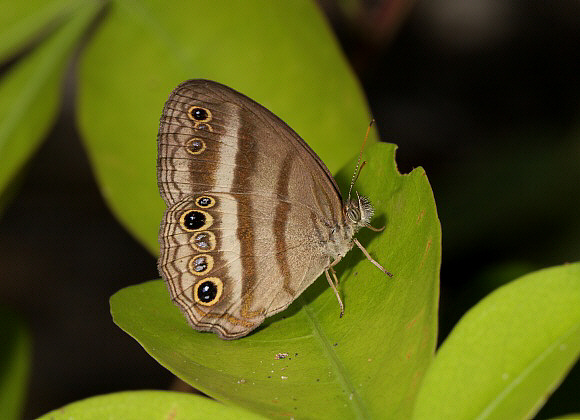
Introduction
There are 1100 known species of Satyrinae in the neotropical region. About 400 of these are placed in the Euptychiina. Butterflies within this tribe include the “ringlet” genera Euptychia, Magneuptychia, Harjesia, Cissia, Caeruleuptychia, Magneuptychia, Harjesia etc; together with Oressinoma and the various “wood nymph” genera i.e. Parataygetis, Posttaygetis and Taygetis. Most are inhabitants of the forest understorey and tend to fly close to the ground. They generally avoid sunlight and prefer to fly at dawn or on cloudy days when light levels and temperatures are low.
Until fairly recently almost all of the “ringlets” were placed in the genus Euptychia, but revisions by Forster and Lamas divide this “convenience” genus into a number of smaller genera, on the basis of anatomical differences and larval foodplants.
The 15 Cissia species are smaller than most other members of the Euptychiina. They are generally a dull plain earthy brown colour on the upperside. On the underside they are pale brown with broad dark brown bands and a creamy outer band. The hindwings have 2 large black ocelli within each of which is a pair of silvery highlights.
Cissia terrestris is a common and widespread species, found from Nicaragua to Bolivia.
Habitats
The habitats of this species include lowland primary and secondary forest, cloudforest up to about 1800m, and disturbed semi-open habitats such as roadsides and clearings in forested areas.
Lifecycle
I have no information specific to terrestris. The lifecycle is likely to be similar to that of other Cissia species, all of which produce round eggs with vertical striations. The eggs are laid either on or near the foodplants, which according to species may be either grasses ( Poaceae ), palms ( Arecaceae ), or arrowroots ( Marantaceae ). The larvae unlike those of most other Satyrines only have 4 instars. When fully grown they are brownish in colour with numerous thin darker and paler lines along the back and sides. The body tapers noticeably towards the head and tail. The latter has a pair of short caudal prongs. Like most other Satyrine larvae they are crepuscular or nocturnal feeders, and hide at the base of plants during the daytime. The pupa according to species may be pale green, brown or blackish, mottled or peppered with darker markings. It hangs by the cremaster from a stem or leaf of the foodplant.
Adult behaviour
As with other Cissia species, the butterflies are solitary in behaviour, but invariably several will be found within the same vicinity. They fly in cloudy or sunny conditions, and can be found deep within the forest, or in open areas such as forest edges or along sunlit forest tracks.
